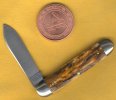christusvictor
Gold Member
- Joined
- Aug 23, 2013
- Messages
- 361
My top 3
1) I owned it and sold it, and now have remorse. Rebuying has never scratched the itch and I almost always end up remembering why I sold it.
2) High weight that is not evenly distributed. I can do 3+ ozs but I need that to be distributed across the whole knife, not all in the bolster.
3) The unobtanium factor. I have no interest in hustling for drops. I can also never recommend such a knife to a friend.
1) I owned it and sold it, and now have remorse. Rebuying has never scratched the itch and I almost always end up remembering why I sold it.
2) High weight that is not evenly distributed. I can do 3+ ozs but I need that to be distributed across the whole knife, not all in the bolster.
3) The unobtanium factor. I have no interest in hustling for drops. I can also never recommend such a knife to a friend.




